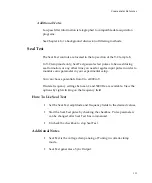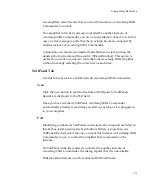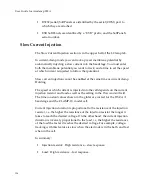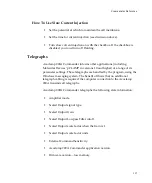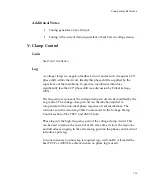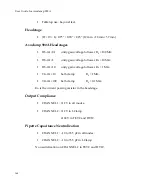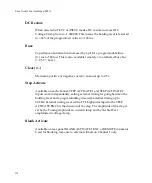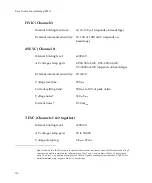
User
Guide
for
Axoclamp
900A
Suggestions:
Either
get
another
D/A
converter
or
lowpass
filter
the
voltage
command
signal.
Select
the
filter
cut
‐
off
frequency
such
that
the
rise
time
of
V
cmd
is
faster
than
the
rise
time
of
the
CHANNEL
1
microelectrode
voltage.
The
V
cmd
signal
should
not
be
the
limiting
factor
determining
the
clamp
step
response
rise
time.
Never
apply
filtering
to
V
cmd
as
a
way
of
compensating
for
performance
in
the
voltage
clamp
setup—this
is
a
false
benefit.
Symptom:
Extraneous
noise
in
the
V
m
signal.
V
m
may
drift
several
mV/min.
Possible
cause:
The
Ag/AgCl
pellet
or
Ag
wire
in
an
electrode
holder
may
be
defective.
Suggestions:
Check
the
DC
stability
of
the
various
voltage
recording
and
bath
ground
electrode
holders
and
replace
where
necessary.
Symptom:
Time
‐
course
of
the
voltage
step
is
faster
than
the
current
transient.
Possible
causes:
1)
A
large
series
resistance
or
2)
the
cell
is
not
isopotential.
The
latter
is
common
when
you
voltage
clamp
a
neuronal
soma
with
an
axon
and
dendrites
attached.
The
slower
components
in
the
current
transient
are
due
to
charging
of
the
distributed
capacitance
of
these
processes.
In
the
absence
of
significant
series
resistance
the
voltage
recorded
is
an
accurate
representation
of
the
soma
potential,
but
not
that
in
the
processes.
Series
resistance
exaggerates
the
difference
in
time
course.
Suggestions:
1)
Reduce
the
series
resistance
(see
Series
Resistance
and,
if
using
TEVC,
Bath
Error
Potentials
in
Chapter
4)
or
2)
if
your
cell
is
not
isopotential
there
is
not
much
you
can
do
short
of
cutting
off
or
ligating
the
processes.
Space
Clamp
There
is
one
limitation
to
the
performance
of
the
voltage
clamp
that
cannot
be
electrically
compensated.
This
is
the
deviation
of
the
cell
from
a
sphere
centered
on
the
tip
of
the
voltage
‐
recording
microelectrode.
The
voltage
clamp
is
maintained
at
the
tip
of
the
voltage
‐
recording
microelectrode.
If
all
164




